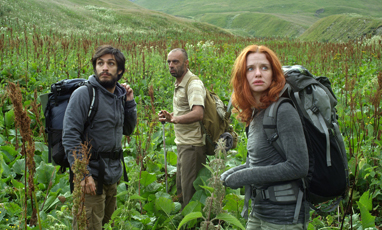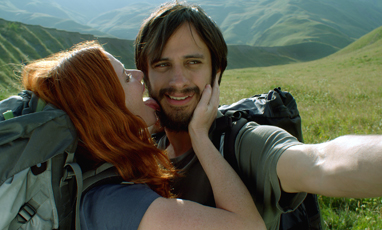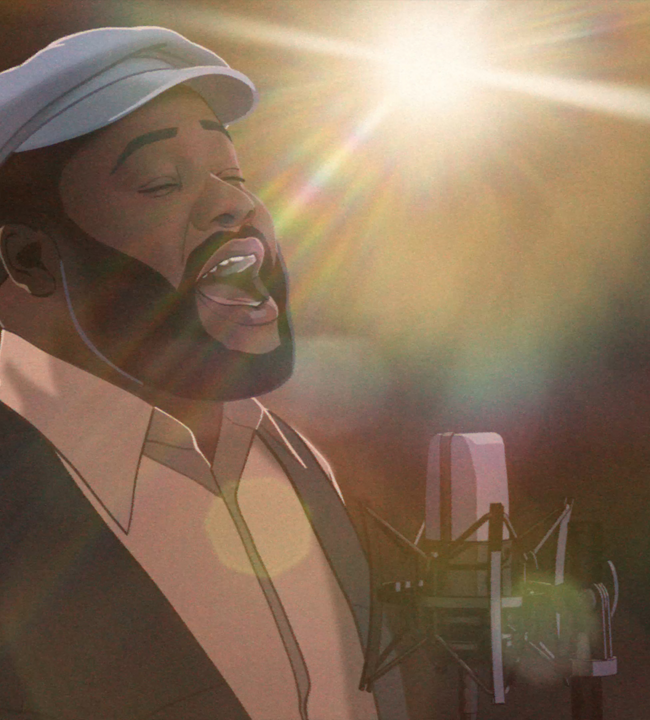A Conversation With Julia Loktev (THE LONELIEST PLANET)
Julia Loktev garnered international attention when her feature debut, Moment of Impact won her the Directing Award for Documentary Film at the 1998 Sundance Film Festival. Her second film and her first foray into feature length fiction, Day Night Day Night, arrived in 2006 and won the Prix Regards Jeune in the Director’s Fortnight section of the 58th Cannes Film Festival. Her latest film, The Loneliest Planet debuted at the 2011 Locarno Film Festival before being acquired by Sundance Selects, who are releasing the movie on VOD and in theaters this week. The film is also nominated for a 2012 Gotham Award for Best Feature.
You can read Veronika Ferdman’s Hammer To Nail review of the film here.
Hammer To Nail: I wanted to start by talking about your choice of location. Visually, this landscape is not something we’ve seen very often, it’s a unique place. Can you talk about process of finding this location and also about how you used it to generate the film’s tone.
Julia Loktev: I looked at a bunch of mountains all over the world using, well, Google Earth, actually. (laughs) I spent a lot of time Google Earth traveling. Initially, I had gotten the idea to make the film while I was in Georgia, so it totally makes sense that we ended up filming it there, but it was this one particular area of Georgia that was very distinct because the mountains are so huge and so open and so green. I think the film would have been totally different if we were in a rocky landscape, like an arid or a desert landscape. Which is the standard thing to do when you have an emotionally difficult film, they like to put them in these arid landscapes. There is something about this film though, that is emotionally very hard taking place in this lush landscape, that was very interesting to me. Plus, the fact that there are no trees in this particular area of Georgia, so you have these weird looking, huge mountains that like look a golf course exploded on them, with these strange orange minerals that run through them and it ends up looking almost like science fiction. There are a lot of beautiful places in Georgia that might have worked, but imagine the film taking place among trees; it’s a completely different movie.
H2N: Visually, how did you create the film once you found this place?
JL: I saw it and it just felt right. And then within that, we had to find the specific mountain for each specific scene, which I was very precise about because we were working radially from one village and going to different mountains within a couple hours’ drive and then hiking in from there. But I did a storyboard or, really, it was more like a score, of these mountain pictures trying to decide which scene to shoot in front of which mountain and how that location would affect the scene. I tended to take the most beautiful locations for the times when things were the most miserable; I didn’t want it to be “Oh, things are hard between them, so let’s be sure they’re in this rocky, hard landscape.”
H2N: The film has a real painterly quality to it in terms of the compositions you guys accomplished. Can you talk about the framing of the film? You use the frame to isolate, to bring your characters together, to set up relationships. The geometry of it is very compelling.
JL: To me, with an image, the framing is absolutely crucial because it is establishing relationships, but I had all of these strange little rules. For example, I never wanted us to see the sky. You asked about the mountains and how we shot them was crucial; we didn’t want to do standard postcard shots or summits and skies, we tried to avoid that and instead create interior space within the mountains, so they were really closing in on the characters. I work out each shot and the choreography on the spot; I can’t plan it in advance. Objects in my head are not as they appear in real life, (laughs), so I have to get to the location and see what the scene might be, see how the actors would move, see how the camera would move with them, and choreograph the scene, because most scenes are in one shot. So, just figuring out the choreography of the elaborate dance between the three characters and the camera for each shot was a major part of what we were doing on set.
H2N: What were the set ups? It seems like a light, flexible shoot from an audience perspective…
JL: It was light and portable in the sense that we only had about a dozen crew members. It was important to me that we could be mobile because we were hiking; we had to hike into the locations a lot of the time with everyone carrying what they could on their back. Ultimately, though, it was also very constrained, and I think the real reason for that was the sun; that’s what killed us. I had no idea how hard that was going to be and I’ve been thinking about that a lot because I’ve been looking at the making of footage and I forgot how hard it was. they say that after you give birth you forget the pain, but looking back, wow. It was a hard shoot because in order to get the right look, we had very limited windows of opportunity. We couldn’t shoot during the middle of the day because the sun was too strong; everything was too contrasty, it looked hideous, so we had to use the first light of the day and the last couple of hours before you hit magic hour because we wanted a very even light. It was like having your hands tied because we could also only shoot in one direction at any given time, so we would rush to get set up, shoot, and then the crew would spend most of the rest of the day reading, playing frisbee and getting exhausted from that, and then they’d have to be on for two hours in the late afternoon. It was mad.
H2N: The consistency of the light does really come through.
JL: It was definitely a well planned and time consuming consistency in terms of labor. You can’t really argue with nature, you can only adapt to it. I’ve never been as aware of light as I was during this shoot. Every single nuance in the light, how it would affect the look of the shot; you see it over the course of the takes. In the morning, the first take, the light is great, then the actors are getting better and better and the light is getting worse and worse. So, you’re constantly battling with it, every moment of the shoot, because with today’s way of making low-budget movies, you don’t have the luxury to wait for the light. I was talking to a Georgian cinematographer who was saying “Back in the days of the Soviet system, the DP would go outside and say ‘I don’t like the light today, I don’t think we’ll shoot’,” and they would wait! Somebody told me a story that they were going to shoot a scene at the top of a mountain and they waited 17 days to shoot it. We didn’t have that luxury. It was a humbling experience.
H2N: Working with the actors under these circumstances must have also been a challenge. Most of your scenes are long takes and it seems there is not a lot of margin for error in these very precise movements. Ho did you work with the actors with the light and crew moving one way and you needing to keep your actors fresh and precise at the same time?
JL: Yeah, I mean, it was definitely a challenge because they also had these very precise, choreographed movements, they had to hit certain marks, but they managed to look incredibly natural doing it, which is a testament to their talent. somehow, in the midst of this precision, we managed to get scenes that audience members think are improvised, which they are the furthest thing from, but the performances feel that way, which is nice. I think with each actor it’s different, I think each one needs something from you. I worked differently with each of them. You just try to figure out what works. Sometimes you screw up and tell them something that doesn’t work, but that’s just normal human behavior.
H2N: Your work has a very consistent tone. All three of your films rely heavily on tone, which is hard to describe, but you seem to derive tension from what isn’t happening, allowing the viewer to build this up in their mind. How aware of you are that on the set, or how much comes in editing.
JL: I think I have a feel for the movie I want when I am on set, but I also like to interrupt tone. For example, all of my films have moments of inappropriate humor and suddenly it shifts. I like that shift, catching you off guard, and then you go into a different scene and you feel the change. Instead of smoothing my moments together, I tend to like really drastic cuts. I never use dissolves in image or sound, and you may never notice it consciously, but you feel it subconsciously that there are these sharp cuts in the sound and image. So, I like to maintain disruption.
But I also set up rules for myself. We decided, as I said, to not show the sky. We had a rule to only use diegetic music except in the case of what we called the “larva shots”; these extreme wide shots where the actors are the size of larvae, and then only music and no natural sound. and those rules create a kind of rhythm and structure and the tone falls into place.
JL: Yeah, we didn’t do a lot of cutting within scenes, because each scene was within one shot, so we had a general idea of the order of things, but then sometimes it felt more right to move a scene into a different spot. So, there was some shifting, more in the first half of the film than the second.
H2N: You mentioned disruption, and in this film, at the midway point, the film takes a profound turn. I don’t want to give it away, but this moment reorders your thinking about the film.
JL: Absolutely, the moment comes from the Tom Bissell short story and it is what attracted me to the film. It’s this turning point which, I guess someone measured it and it was less than two seconds, but it is huge in terms of its implications and it is so confusing. I mean, it’s very clear what happens, the fact of what happens is there, but how to act after? How might I act after? How I would act if a man that I loved did that to me was very confusing. How would he feel? That is kind of what attracted me to the story; it’s about this event that neither character has any idea how to deal with emotionally. Yes, it’s about gender roles, but fundamentally, it’s about seeing someone you love in a way you’d never expect and seeing yourself in a way you’d never expect.
I was doing this interview with this woman and she said “My husband would never do that.” and all I could think was “what if he did?” I’m sure everyone in the film felt the same way, I am sure most men would say “I would never do this.”
H2N: Actually, if you’re honest with yourself, I think the possibility is what makes it authentic. It seemed an unconscious action…
JL: Exactly! There is a possibility you might do this. And then the question becomes how big of a deal is it that he does do it? That’s the real question and people have very personal, emotional responses to that.
H2N: The film leaves this unresolved; you’re asking are they capable of forgiveness, which is the most profound question the movie really raises…
JL: And that’s the question that interested me the most. How do people go about forgiveness, both each other and themselves? But I think it is true that anyone who has a relationship that lasts a long time, has probably forgiven the unforgivable. And more than once. I mean we could end on… and now they’re married! And that seems a little cheesy to me. But there is something in the last scene, a little gesture, it’s very tiny, that maybe opens up some hope. I think the second half of the film is a process, an awkward push-pull attempt at reconciliation. It is about that, and it’s an out of synch movement, that don’t seem to come toward one another at the same time, but they don’t verbalize it. We even tried filming a scene where they would talk and it didn’t work. To me, it was a scene about the impossibility of talking. What the hell do you say? Is saying “I’m sorry” appropriate here? It’s obvious he’s sorry. And to say you’re sorry, do you have to forgive yourself first? In the scene, they tried to talk about it and it just didn’t go very well. In the end, it seemed stupid to include the scene. You don’t need it.
H2N: You’ve done a great job of giving viewers contemplative space to find their way into the film. Does that register for you as an artist?
JL: I’m glad you said that. I’m not sure if I think about it consciously, but I like movies that leave me thinking after, where there is space to think after the film and everyone doesn’t think the same thing. But I also like the space to think within the film and maybe that’s why I included these extremely wide shots of them walking with music, to have these space where you can be there and have a moment to be with your thoughts. It’s important here too because this is a film about people hiking in the mountains, and when you are hiking, there’s so much space to think and contemplate. And sometimes, you’re thinking nothing at all, or you focus on your next step or wonder when it will be over, but it is such a contemplative space, so it was important to me that the film had that sense.
— Tom Hall














Pingback: HOME VIDEO PICKS – Hammer to Nail